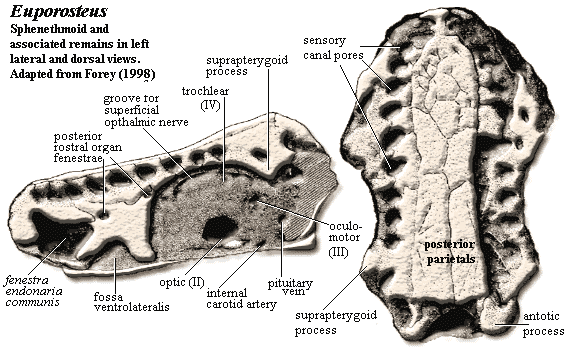 Euporosteus: Jaekel 1927) E. eifeliensis Jaekel, 1927. Only ethmosphenoid, with some attendant scraps, is known.
Euporosteus: Jaekel 1927) E. eifeliensis Jaekel, 1927. Only ethmosphenoid, with some attendant scraps, is known.| Sarcopterygii | ||
| The Vertebrates | Euporosteus |
| Vertebrates Home | Vertebrate | Vertebrate |
|
Abbreviated Dendrogram
Teleostomi
├─Neopterygii
└─Sarcopterygii
├─┬─Onychodontiformes
│ └─Actinistia
│ ├─Diplocercides
│ └─┬─Euporosteus
│ └─┬─Hadronector
│ └─┬─Rhabdoderma
│ └─Coelacanthiformes
└─Rhipidistia
├─Dipnomorpha
└─┬─Rhizodontiformes
└─Osteolepiformes
├─Tristichopteridae
└─Elpistostegalia
├─Panderichthys
└─Tetrapoda
|
Contents
Overview |
Like the fossil, these comments don't consist of a great deal -- a pair of brief items that anyone with half a brain (which, in this case, is all we have) could work out. These reflect petty irritation with Forey's description of Euporosteus: things which, one might say, we have half a mind to tell him.
In terms of rostral structure, Euporosteus makes a very pretty intermediate between the basal sarcopterygian type, such as Miguashaia, and the rest of the coelacanths. As in other basal forms, the rostrum is very wide, the cheek long, the interorbital septum angled, and (we assume) the wings of the ethmoid diverged widely at the front end. However, unlike the Early Devonian forms, the orbits of Euporosteus are located laterally, with the jaw rami probably long and approaching a more parallel orientation. The movement of the orbits to the side of the head evidently necessarily created a great deal of new anatomical space on the rostrum rather quickly. In fact, by the standards of Carboniferous coelacanths, Euporosteus has a sloppy, inefficient look to its rostrum. The posterior openings of the rostral organ are widely divergent, the nasal cavity is enormous, and the fossa ventrolateralis is several times larger than in any other known coelacanth. In fact, as Forey 1998) points out, the rostrum accounted for half the length of the sphenethmoid region.
This peculiar arrangement raises an issue we have mentioned before, namely the problem of vision when one's eyes are directed somewhat posterolaterally. Again, this is a necessary geometrical consequence of moving the orbits to the side of the head while the skull still expands anteriorly. We suspect this geometrical constraint, together with a peculiar ledge under the optic foramen, clinches the case for eyestalks in basal Actinistia. Forey makes the half-hearted argument that this "swelling" is some sort of anteriorly misplaced basipterygoid process. That isn't possible without half-blinding the fish, or developing a pterygoquadrate in the shape of a distorted question mark. The ridge makes much better sense as a relatively conventional process for attachment of an eyestalk. ATW060120.
 Euporosteus: Jaekel 1927) E. eifeliensis Jaekel, 1927. Only ethmosphenoid, with some attendant scraps, is known.
Euporosteus: Jaekel 1927) E. eifeliensis Jaekel, 1927. Only ethmosphenoid, with some attendant scraps, is known.
Range: Late Devonian of Europe.
Actinistia ::: (Hadronector + (Allenypterus + Holopterygius) + (Lochmocercus + (Polyosteorhynchus + (Caridosuctor + (Rhabdoderma + Coelacanthiformes)))))) + *.
Characters: dermal skull largely unknown [F98]; rostral region long & wide [F98]; parietonasal shield probably broad [F98]; posterior parietal long, with very small descending process [F98]; perhaps 10 tectals (including 6 supraorbital) [F98]; antorbital probably standard [F98]; ethmosphenoid completely ossified [F98]; processus connectens long & reaches level of parasphenoid [F98] [2]; dorsum sellae and sphenoid condyles weakly developed [F98]; well-developed suprapterygoid and antotic processes, separated by insertion of adductor arcus palatini [F98]; interorbital septum broad and flaring (somewhat as Miguashaia and basal sarcopterygians) with anterior portion of brain probably located here [F98]; below optic foramen is longitudinal ridge unique to Euporosteus, possibly basipterygoid process [F98] [1]; posterior nasal wall with three foramina (as Diplocercides): superficial ophthalmic branch of anterodorsal lateral line nerve, profundus nerve, anterior cerebral vein [F98]; single large endonarial fenestra [F98]; vomers probably large and separated at midline [F98]; parasphenoid very broad, with whorls of villiform teeth [F98].
Notes: [1] or perhaps homologous to the basisphenoid pillar and not unique to Euporosteus. [2] ??!).
References: Forey 1998) [F98]. ATW060120.
checked ATW041103